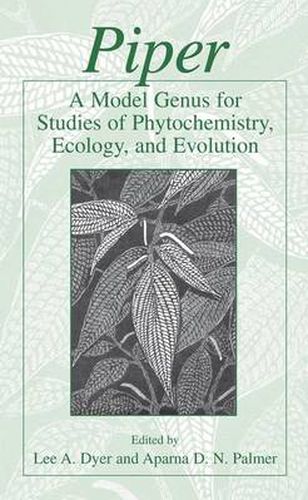Readings Newsletter
Become a Readings Member to make your shopping experience even easier.
Sign in or sign up for free!
You’re not far away from qualifying for FREE standard shipping within Australia
You’ve qualified for FREE standard shipping within Australia
The cart is loading…






This title is printed to order. This book may have been self-published. If so, we cannot guarantee the quality of the content. In the main most books will have gone through the editing process however some may not. We therefore suggest that you be aware of this before ordering this book. If in doubt check either the author or publisher’s details as we are unable to accept any returns unless they are faulty. Please contact us if you have any questions.
Piper is an economically and ecologically important genus of plant that includes a fascinating array of species for studying natural history, natural products chemistry, community ecology, and evolutionary biology. The diversification of this taxon is unique and of great importance in understanding the evolution of plants.
The diversity and ecological relevance of this genus makes it an obvious candidate for ecological and evolutionary studies, but surprisingly, most research on Piper spp. to-date has focused on the more economically important plants P. nigrum (black pepper), P. methysticum (kava), and P. betle (betel leaf). While this book does address the applied techniques of studying Piper, its focus is more on Piper in its natural setting. Piper: A Model Genus for Studies of Phytochemistry, Ecology, and Evolution synthesizes existing data and provides an outline for future investigations of the chemistry, ecology, and evolution of this taxon, while examining its key themes of Piper as a model genus for ecological and evolutionary studies, the important ecological roles of Piper species in lowland wet forests, and the evolution of distinctive Piper attributes.
This volume has a place in the libraries of those studying or working in the fields of ecology, evolutionary biology, natural products chemistry, invasive species biology, pharmaceutics, and ethnobotany.
$9.00 standard shipping within Australia
FREE standard shipping within Australia for orders over $100.00
Express & International shipping calculated at checkout
This title is printed to order. This book may have been self-published. If so, we cannot guarantee the quality of the content. In the main most books will have gone through the editing process however some may not. We therefore suggest that you be aware of this before ordering this book. If in doubt check either the author or publisher’s details as we are unable to accept any returns unless they are faulty. Please contact us if you have any questions.
Piper is an economically and ecologically important genus of plant that includes a fascinating array of species for studying natural history, natural products chemistry, community ecology, and evolutionary biology. The diversification of this taxon is unique and of great importance in understanding the evolution of plants.
The diversity and ecological relevance of this genus makes it an obvious candidate for ecological and evolutionary studies, but surprisingly, most research on Piper spp. to-date has focused on the more economically important plants P. nigrum (black pepper), P. methysticum (kava), and P. betle (betel leaf). While this book does address the applied techniques of studying Piper, its focus is more on Piper in its natural setting. Piper: A Model Genus for Studies of Phytochemistry, Ecology, and Evolution synthesizes existing data and provides an outline for future investigations of the chemistry, ecology, and evolution of this taxon, while examining its key themes of Piper as a model genus for ecological and evolutionary studies, the important ecological roles of Piper species in lowland wet forests, and the evolution of distinctive Piper attributes.
This volume has a place in the libraries of those studying or working in the fields of ecology, evolutionary biology, natural products chemistry, invasive species biology, pharmaceutics, and ethnobotany.